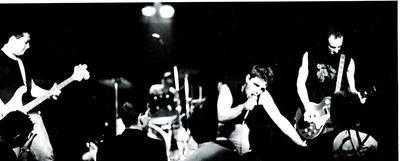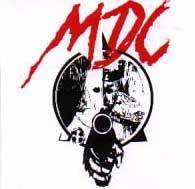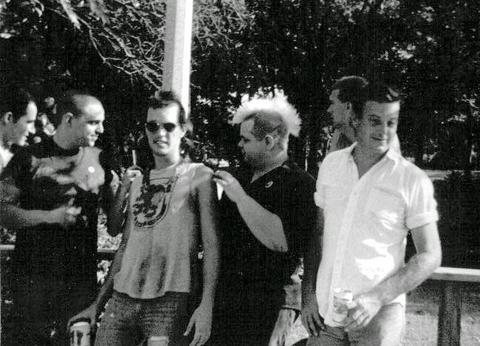I grew up near a place called “The Crossroads”,
locally reported to be the place in the Robert Johnson song. The area,
located near the corner of Rosedale and Riverside in south Ft. Worth,
is such a run down, mean, and haunted place that I am still not
completely convinced that this legend does not contain at least a
kernel of truth. I lived near the Crossroads until I was 16, when I
ran away to Austin to seek my fortune in a better
 place.
place.
Massage parlors and titty bars didn’t ask for a lot of
ID or experience, so do the math. One bar particularly stands out in
my memory. I swear it was the model for the bar in the film version of
“Sin City”. It was over on Airport Boulevard between Burnet Road and
the mall. When I was nineteen, I saw someone shot right in front of me
while I was onstage dancing to Lou Reed’s “Sweet Jane”. While I was
naked. I don’t know why it’s much worse to be naked when someone gets
shot in front of you, but it is, somehow. I heard later it was a blown
speed deal between some bikers.
Music was my biggest outlet back then, perhaps the one
thing that kept me from going to pieces. Above all things I liked to
go out by myself on my nights off and listen to bands. I found out
about the Armadillo, the Alamo Hotel, Antoine’s (downtown in those
days), and the Rome Inn, and I spent a good portion of my tip money on
record albums, cover charges, and music magazines. I would go home
after another shitty night at work at my degrading job and listen to
Iggy or the Dolls and get drunk and high and pound my head on the
floor and feel somewhat better for it.
Then a new club opened on the Drag. Raul’s was small
and dark, with a low ceiling. It was local music that sounded like the
music I liked, and everyone was accessible and friendly. There was a
wonderful rat mural on the wall, painted by the first two real witches
I ever met. Suddenly it was OK to be a misfit, OK to be poor, and OK
if your life wasn’t perfect like the TV sitcoms you used to watch
after school smoking weed until your mom came home and got drunk and
threw shit at you. More importantly, the people were just as goofy and
weird and bruised as they wanted to be, without feeling that they had
to make any apologies for it. I had never had a crowd of people like
me before unless I was pretending to be someone I wasn’t.
The decadence of the seventies gave way to the harsher
political and economic realities of the eighties. Hardcore’s time had
come, and the three bands that best exemplified Austin’s take on
hardcore were the Dicks, the Big Boys, and the Stains (later M.D.C.).
They were amazing bands to watch, and they were nice to talk to.
Raul’s closed down much too soon, and the scene moved over to Duke’s
Royal Coach Inn (the site of the historic Vulcan Gas Company), the
Ritz, and Club Foot.
A lot of the people in the scene moved out to SF in
the early eighties, and I drifted along, hoping to cover my tracks and
start working straight restaurant jobs, maybe even go to chef school.
Some of the Austin bands were squatting at an abandoned Hamm’s brewery
South of Market, known as the Vats. It was squalid, cold, and drafty,
but something happened there with sound, and it is for this reason
that the place is now legendary.
legendary.
Hardcore shows were perceptually overwhelming, and
their sparse visual aesthetic tended to make them more so. The Vats
was a series of huge metal tanks that had been converted into crude
band spaces. The top floor had huge open holding vats, big as crushers
in a mine. The metal walls and floors vibrated when bands played,
enhancing bone conduction of sound waves until it felt like the music
was radiating deep from within the core of your body. My heart would
always race for about the first half hour until it felt like I was
going to vibrate apart, then would slow down into an almost pranayama
state, synchronized to the music. It felt good, down in your guts,
like it was creating waveforms that were oscillating away all the pain
and anger that was sucking your soul away.
I still wonder about what the physiological effect
being at the Vats had on the human brain. Firing nerve fibers entering
the cochlear nuclei synchronize to sound at low frequencies. Very low
frequency waves travel along the entire surface of the basilar
membrane, growing progressively slower as they move into the brain.
Mechanical energy from the music transferred to the metallic structure
of the building, turn amplifying bone conduction through the body,
initiating waves along the basilar membrane comparable to the movement
of spatial summation of impulses that caused somesthetic sound images
became synesthetic and haptic. At least, that’s my idle speculation.
If you gave yourself over to the experience, you could
reach enough of an altered state that allowed a near-total personal
catharsis to be experienced within the context of a group phenomenon.
For people of a certain disposition, that was healing; and I was of
that disposition. I think that for a lot of us, the music became a
pivotal point in learning to deal with the frustrations of being
young, poor, working at a miserable low paying job, and trying to pay
for school or whatever the fuck it was you were trying to do with your
life. It certainly helped me deal with the reality of growing up with
shitty drunk parents, followed by working underage in a scary, smelly
titty bar being pawed by assholes for what ultimately amounted to not
as much money as everyone likes to think. Hardcore music didn’t seem
to lift me out of my life as much as it gave me a kind of armor to
deal with it.
It had its dark side as well. Physical demands,
poverty, and social dynamics wore people down. Chemical gods that rest
uneasy beneath the surface of expediency and hopelessness extracted
their pound of flesh from many. After having broken the boundaries of
the way that the human body can create and relate to vis ceral
experience, it is not always easy to find your way home again,
especially if home sucked in the first place. If that left some people
singing the tombstone blues, it is hardly surprising.
ceral
experience, it is not always easy to find your way home again,
especially if home sucked in the first place. If that left some people
singing the tombstone blues, it is hardly surprising.
The Eagle’s Nest is a small club in the Folsom, dark
and close. The ceiling is low, and there are murals on the walls of
biker daddies. The people there dress however they please, and they
are friendly and accessible. At one point during the Buddha Brothers
set I looked around and saw two of the founding members of MDC
standing on either side of me; we all met at Raul’s almost three
decades in the past. Those days weren’t exactly glory days, marked as
they so often were by sadness, self-abuse, and bone-grinding poverty.
Nevertheless, they were special in a sense that it had led me to see
isolation as illusion, and anger as something that can be used to
create positive change. I never figured out how to get enough money to
go to the Culinary Arts Academy, but these days I’m pretty OK with
that.
Bound together by what was then a new language with a
syntax that embraced the common good of the alienated, and an artistic
aesthetic that stood in stark refusal of rage in homeopathic doses, an
intentional community somehow unintentionally became reality. Austin’s
original punk generation still stands-up front, no less-having gone on
to be teachers, counselors, even musical legends, to be people who
retain a sense social activism, people who despite personal troubles
are still finding ways to create change. It is this, perhaps, rather
than an unusual somatic phenomenon, that made the hardcore experience
ultimately so unique and life changing.